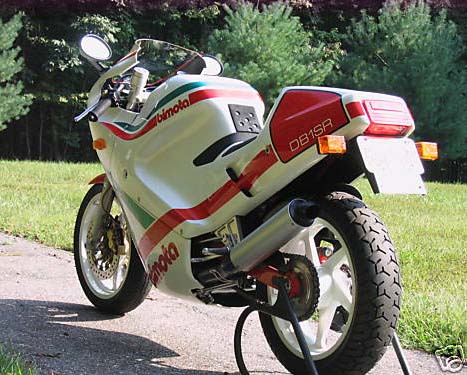
|
|
|
|
|
|
Classic Bikes
Custom Bikes
Individual
Racing Bikes AJP
AJS
Aprilia
Ariel
Avinton / Wakan
Bajaj
Benelli
Beta
Bimota
BMW
Brough Superior
BRP Cam-Am
BSA
Buell / EBR
Bultaco
Cagiva
Campagna
CCM
CF Moto
Combat Motors
Derbi
Deus
Ducati
Excelsior
GASGAS
Ghezzi Brian
Gilera
GIMA
Harley Davidson
Hero
Highland
Honda
Horex
Husaberg
Husqvarna
Hyosung
Indian
Jawa
Kawasaki
KTM
KYMCO
Laverda
Lazareth
Magni
Maico
Mash
Matchless
Mondial
Moto Guzzi
Moto Morini
MV Agusta
MZ / MuZ
NCR
Norton
NSU
Paton
Peugeot
Piaggio
Revival Cycles
Roland Sands
Royal Enfield
Sachs
Sherco
Sunbeam
Suzuki
SWM
SYM
Triumph
TVS
Ural
Velocette
Vespa
Victory
Vincent
VOR
Voxan
Vyrus
Walt Siegl
Walz
Wrenchmonkees
Wunderlich
XTR / Radical
Yamaha
Zero
Video
Technical
Complete Manufacturer List
|
Bimota DB1SR Serie Finale |
| . |
|
Make Model |
Bimota DB1SR |
|
Year |
1987 (production 153) |
|
Engine |
Four stroke, 90°“L”twin cylinder, SOHC, desmodromic 2 valves per cylinder (Ducati 750 Pantah) |
|
Capacity |
748 cc / 45.6 cub in. |
| Bore x Stroke | 88 x 61.5 mm |
| Cooling System | Air cooled |
| Compression Ratio | 10.4:1 |
| Cooling | Air |
|
Induction |
2x 41mm Dell'Orto carbs |
|
Ignition |
- |
| Starting | Electric |
|
Max Power |
59 kW / 80 hp @ 9200 rpm |
|
Transmission |
5 Speed |
| Final Drive | Chain |
| Frame | Load bearing space frame structure made of chrome-molybdenum steel |
|
Front Suspension |
41.7mm Telescopic M.1.R Marzocchi with 4-way rebound damping |
|
Rear Suspension |
Rising rate linkage with Marzocchi shocks with adjustable preload 11 position compression damping |
|
Front Brakes |
2x 280mm discs 1 piston calipers |
|
Rear Brakes |
Single 260mm disc |
|
Front Tyre |
130/80 V16 |
|
Rear Tyre |
160/80 V18 |
|
Dry Weight |
160 kg / 352.7 lbs |
|
Fuel Capacity |
22 Litres / 5.8 US gal |
| Standing ¼ Mile | 12.6 sec / 167 km/h / 104 mph |

The DB1 was the first Ducati-engined bike from Bimota. Originally the developed started as a joint project between Bimota and Ducati. Due to due difference between the two companies the bike was then built only by Bimota. Ducati then built a similar Ducati Paso.
Bimota built the DB1 between 1985 until 1990 with a 750 cc Ducati 90° V-twin engine with Desmodromic valve-train in different levels of tune and styling. It was build in 4 variants: DB1, DB1S, DB1SR and the DB1SR Serie Finale. A DB1J (400cc) was also build during this production run.
The frame is made of Chrome-Molybdenum steel tubing and uses a Triangulated Upper Space Frame or "Birdcage" design. The engine is a stressed member and the swingarm pivots in engine's crankcase. The DB1s triple-trees, clip-ons, rear-sets and several other bits are made of lightweight, hot stamped and billet Avional 14 aluminum.
DB1 (400 units build)
Several DB1 models were produced. The standard DB1 has 36 mm carburetors, a
restrictive airbox and a quiet 2-into-2 exhaust. It was made between 1985 and
1986 and while not powerful it is extremely refined.
DB1J (53 units build)
A 400 cc version of the DB1, for the Japanese market, was produced between 1986
and 1987.
DB1S (63 units build)
The DB1S is a slightly higher performance version of the 750 cc DB1 with 40 mm
carburetors and freer 2-into-2 exhaust and was made between 1986 and 1987. Both
the DB1 and the DB1S needed re-jetted upon delivery to run properly and make
proper horsepower for the design.
DB1SR (153 units build)
The DB1SR is an even higher performance version with 4-piston front calipers, 41
mm carburetors, freer 2-into-1 exhaust and more radical cam shafts and was made
between 1987 and 1989. Confusingly, most DB1SRs are labeled "DB1RS" on the
fairing and some are styled differently with a rear red number plates and
correctly labeled "DB1SR". The DB1SR can be compared to Ducati's Laguna Seca/Montjuich/Santa
Monica models, upgraded 750 F1s.
The DB1SR was successfully raced in Italy by Tiziano Bombardi, winning the 1987
Italian Sport Production Twins Championship, finishing on top of the podium in 8
of the 9 races, with one second-place finish.
DB1SR Serie Finale (7 units build)
The DB1SR Serie Finale is similar in performance and style to the DB1SR yet with
a green stripe and a silver plaque on the right side of the swingarm. These
bikes were assembled in 1990 using the last 7 DB1 frames at the request of the
Bimota Club USA President upon visiting the Bimota Factory. Three went to the
US, at least one went to Japan, at least one went to France.
DB1R (10 units build)
The DB1R is a Factory Corsa (race), or Works, bike made between 1985 and 1986.
These bikes have many enhancements including several parts made of magnesium,
different triple-trees (29° vs. 25°, identical trail at 105 mm), high
performance engine internals, higher rear-sets, 42 mm carburetors, open 2-into-1
exhaust and no lights with the oil cooler in the nose of the fairing. DB1R
frames don't have the three fuel cell mounts, the two steering stop mounts or
the keyed steering lock (like the DB1/DB1S/DB1SR/DB1SR Serie Finale strada
(street) frames. The aluminum fuel cell is made into the bodywork and can be
identified by the upper vent hose.
Source Wikipedia
|
Any corrections or more information on these motorcycles will be kindly appreciated. |